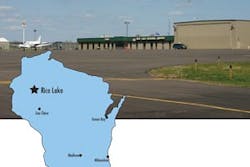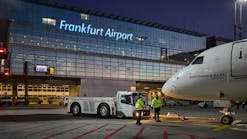Rice Lake, WI — Rice Lake Regional Airport has come a long way since opening at its current location just outside this popular tourist town situated in the woods of northern Wisconsin, with a population of some 8,320. The previous Rice Lake airport was trapped with a lake on one side and a sometimes unenthusiastic town on the other; the current 8,000-acre airport has a recently extended 6,700-foot runway, an expanded terminal, and instrument landing system. Next up: Developing and accommodating the region’s growing need.
“The runway length has really become so important,” airport manager Jerry Stites says. He cites the overrun at Chicago’s Midway Airport a few years ago as being a catalyst. “Since that time, most manufacturers and FAA have issued new operating specs for their jet aircraft.
“Runway length is crucial if you’re going to keep up with accommodating aircraft that the corporations are buying more of.”
Overall, the airport has come a long way since its move to the current site. “The old airport had very limited capabilities,” Stites notes. “The runway was only 3,500 feet. Jets couldn’t land on it. It was close to town; it had lake on the one end, trees on the other. The city in the mid-80s decided they needed to build a new one.
“Ironically, the old airport had airline service. In the mid-80s the FBO there operated, in conjunction with Northwest Airlines, a smaller twin-engine aircraft which shuttled people back and forth to Minneapolis International, connecting with Northwest flights ... back in the days when airlines were aggressive in trying to get ridership.”
Stites says the airport was in talks with airlines around 2001. But, he says, commercial service isn’t a high priority — particularly considering the havoc an airline could cause if it fell behind in paying its airport fees. “We’d love to see an airline here, but it hasn’t been something we’ve aggressively sought. The cornerstone of our airport ... has really been the corporate operator. Not only those based here, but we’ve seen a lot of inbound corporate activity that relies on this airport.”
Stites points out that many corporations have taken root in the Rice Lake area in the past ten years, including Wal-Mart, Hormel, McCain Foods, and other businesses and Fortune 500 companies. “These are large corporations that rely on airports often to get access to their facilities,” comments Stites.
The economic impact of tourism in the county is significant — $111 million in 2007, according to Stites. There is a 4.5-star golf course and upscale resort in the area. “Those people that can afford that are flying here in Gulfstreams,” Stites says. The airport currently records some 25,000 aircraft operations a year.
The overall region has grown as well. Stites notes that the local population has grown some 5 to 6 percent in the past decade, and sales tax collections in the county for the first three months of 2008 are up five percent over the same period last year. “So that tells you about the economy,” he says.
The airport itself has been a positive impact on the local economy — $16 million in 2007, compared with just $1.6 million in 1995 — or from eight jobs the first year up to 44 today.
Contract management
As airport manager, Stites is actually head of his own private company that contracts airport management services to the city. S&S Airport Management LLC pays the operating costs for the airport, including electric, phone, and plowing. Stites sees the arrangement as key to the airport’s success.
“We as a private company can wheel or deal or do anything else we want to do without being controlled,” Stites says. “It works out very well.”
Stites at one time owned the full-service FBO, Rice Lake Air Center, before selling it to Mike Nelms in 2003. Nelms says the FBO sells fuel and offers Part 135 charter, Part 145 maintenance, a flight school, and a service center for the Cicada TBM single-engine turboprop. The Cicada shop has been there some ten years, and the FBO has nine years remaining on its lease.
The FBO’s offices are within the terminal, and the FBO has 24,000 square feet of hangar space in three buildings — two for storage, one for maintenance. Nelms says 8,000 square feet of hangar space was added in 2007. Under the terms of its lease, the FBO pays annual fees of $10,000 for the terminal, $14,666 for the maintenance hangar, and $47,400 for the storage hangar. The airport charges an eight cents per gallon fuel flowage.
There are two corporate hangars on the airport. Another addition is a hangar to accommodate a 24-hour medical evacuation helicopter, Lifelink.
And there is a row of 20 T-hangars owned by the city, installed when the airport was built in 1995. “We knew if we were going to attract fliers to come from the old airport we needed to build something to offer them for rent,” Stites says. “So those are city-owned; they’re all rented and we have eight names on a waiting list, so we’re looking at trying to get more of those built this year.”
Stites notes that the previous airport had only privately owned hangars onsite. The only city-owned building, in fact, was a trailer functioning as the airport terminal. The current terminal, by contrast, was recently expanded on its north side, including space to accommodate potential changes to general aviation security screening. Stites is also working to get a restaurant set up in another terminal expansion next year.
In addition to the restaurant, the airport is in talks with an aircraft manufacturer, and is looking at developing a business and industrial park adjacent to the airport. There is also a railroad track running along the airport’s south side, which Stites says could help attract more aviation businesses.
“We could bring a railroad spur right into the airport,” he notes. “Not many airports can provide rail. A number of aircraft companies build their components somewhere else and assemble their aircraft at a site and ship them by rail, so we feel that the rail service may be one more reason somebody might look at Rice Lake for expanding their aviation-related business here.”
Total investment in construction, land, and improvements since 1995 has been $16 million. The city has invested $4 million, and the remaining money has come from federal and state funding. But future funding may prove more difficult to secure than it has in the past. Rice Lake Regional Airport received almost $6 million in federal appropriations earmarks for projects in the previous three years, Stites says.
“That’s been a very valuable revenue source for improvements at the airport,” Stites comments. “Of course that’s changed quite a bit, with the pressure on the House and Senate regarding earmarks.
“That source of funding is going to be much less. So that leaves us with our entitlement — which is only $150,000 a year, which is not a lot of money.”
Stites is focused on highlighting the return on investment of the airport. “We’re still confident that we can make that case and achieve the funding we need.
“There are a lot of opportunities out there to grow the airport and we want to continue to do that. It’s hard work.”
“There are always naysayers about the airport, that don’t get involved in the airport,” Stites says. “So of course they say ‘why spend your money down there for a few rich people.’”
The airport is the only facility in the region that operates 24 hours a day. “We’re positioned in northwest Wisconsin to serve the entire state. And that’s really what we do,” says Stites.




